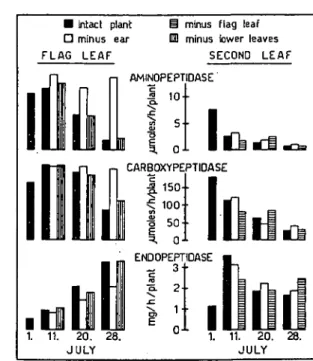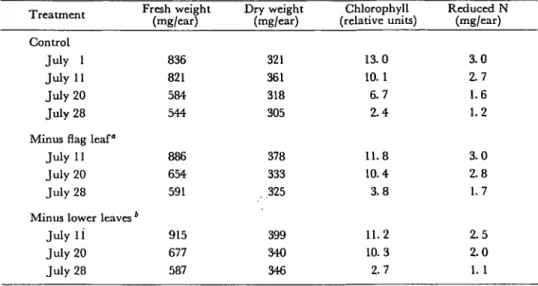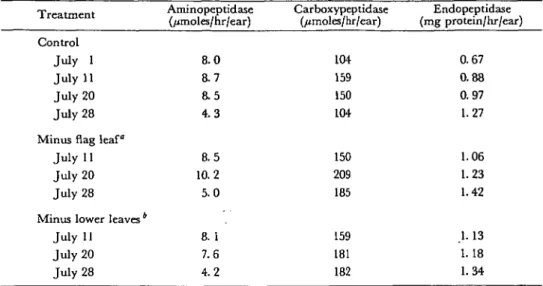Effect of changed source/sink relations on proteolytic
activities and on nitrogen mobilization in field-grown
wheat (Triticum aestivum L.)
Urs Feller
Pflanzenphysiologisches Institut, Universitat Bern, Altenbergrain 21, CH-3013 Bern, Switzerland
(Received September 3, 1979)
Nitrogen mobilization and the pattern of proteolytic enzymes were investigated in leaves and glumes of field-grown winter wheat (Triticum aestivum L.) during maturation. Source/sink relations were changed by removal of the ear, the flag leaf or the lower leaves shortly after anthesis. Removal of the ear was most effective, resulting in delayed senescence of the flag leaf with the chlorophyll, aminopeptidase and carboxypeptidase activities remaining high in contrast to the control, whereas neutral endopeptidase activity increased more slowly. No major changes were observed in the second leaf from the top in plants with either ears or flag leaves removed. Nitrogen mobilization and proteolytic activities in glumes and the remaining leaves were influenced only slightly by leaf removal. In earless plants, nitrogen was transported from the second leaf into the leaf sheath and stem, but in the flag leaf the total reduced nitrogen remained high and free amino groups increased.
The increase in endopeptidase activity was influenced by the source/sink relations. However, the accumulation of amino groups and the increasing endopeptidase activity in the flag leaf of earless plants suggest that the nitrogen sink capacity did not greatly control protein degradation; it remains to be seen whether phytohormones, accumulated amino acids or other factors delayed the increase in endopeptidase activity.
Key words: Glumes — Leaves — Nitrogen mobilization —Proteolytic enzymes — Wheat.
During the senescence of detached (8, 10, 12) and attached (3, 9, 14) leaves of Graminae an increase in extractable proteolytic activity was found. Although endopeptidase activities increased several fold, aminopeptidase and carboxypeptidase both decreased during nitrogen mobilization (4, 5). A situation similar to that in leaves was found in wheat glumes (3, 6). In maturing wheat kernels nitrogen was mobilized from the outer pericarp and from the cross cells to pass into the endo-sperm (6). Endopeptidase activities were high in the outer pericarp and in the cross cells (6, 11), and carboxypeptidase activities also were high in the endosperm. Aminopeptidase showed the highest activities per gram fresh weight in the embryo and the lowest activities in the nitrogen mobilizing tissues (6, 7). In general, the neutral endopeptidase activity (azocasein digestion at pH 7.5) was high in the senescing parts of wheat plants and low in nitrogen sink organs, but exopeptidase activities were not increased or were only slightly increased during nitrogen mobili-zation (5, 6).
The first phase of dark-induced senescence in wheat leaves was reversible {13). Senescence was delayed (8, 10, 13) and reversibility was enhanced (13) in cereal leaves in the presence of cytokinins. These results suggest hormonal regulation of leaf senescence in intact cereal plants.
The objectives of this work were to investigate the influence of altered source/ sink relations on nitrogen mobilization and on the pattern of proteolytic enzymes in leaves and glumes of field-grown wheat during maturation. The source/sink relations were changed by removing leaves or the ear shortly after anthesis.
Materials and methods
Plant material
Winter wheat (Triticum aestivum L., cv. Probus) was planted October 10, 1977 in fertile soil in Zollikofen, Switzerland. The ears or leaf spreads were removed on July 1, 1978 (about one week after anthesis). Samples were analyzed on the day of treatment and at three other times during grain filling. For all treatments four replicate samples containing 3 plants each were harvested and brought in plastic bags on ice to the laboratory. The spreads of the flag leaves and of the second leaves from top then were weighed, and the samples were stored frozen (—20°C) in plastic tubes until the end of the experiment. Samples with intact ears were frozen in plastic bags and subdivided immediately before analysis. After the removal of the kernels, the glume samples contained 10 spikelets from the middle of two ears (five from each).
Extraction and enzyme assays
Three leaves were homogenized in 10 ml of the extraction medium (50 mia acetate buffer pH 5.4 containing 1% insoluble polyvinylpyrrolidone and 0.1% mercaptoethanol) with a Polytron homogenizer (Kinematica, Luzern). For the extraction and sample preparation tubes were kept in an ice bath. For the glume samples, all the glumes (containing glume, lemma and palea) of 10 spikelets were homogenized in 5 ml of the extraction medium. The homogenates were passed through Miracloth (Calbiochem, San Diego), then 1.4 ml portions were centrifuged and desalted through a Sephadex G-25 column as described earlier (4). Activities for aminopeptidase (hydrolysis of L-leucine-j&-nitroanilide), carboxypeptidase (hydrolysis of iV-carbobenzoxy-L-phenylalanyl-L-alanine) and neutral endopeptidase (azocasein digestion) were measured in the desalted extract as reported earlier (5).
Determinations of fresh weight, dry weight, chlorophyll and nitrogen
Leaf fresh weights were determined before freezing. Four spikelets from the middle of the same two frozen ears used for extraction (two of each) were excised and their fresh and dry weights were measured.
Then 1.9 ml of 80% acetone (v/v) was added to 0.1 ml of the uncentrifuged homogenate prepared for the enzyme assays, and after standing for 10 min in iced water the tubes were centrifuged for 5 min at 4,000 Xg. The optical density of the supernatant at 665 nm was used as the relative chlorophyll measurement. Five microliters of the uncentrifuged, well mixed homogenate was analyzed by the ultra-micro Kjeldahl procedure (1). By this method the total reduced nitrogen (organic
and inorganic) was measured but nitrate was not included. The free amino groups were determined with ninhydrin reagent (2) in 10 /n\ of the homogenate.
Expression of data
All the results shown represent the averages of the replicates. Leaf data are expressed per leaf. Glume data were calculated per ear by multiplication of the data per spikelet by the average number of fertile spikelets per ear.
Results
The changes in fresh weight, chlorophyll, total reduced nitrogen and free amino groups during leaf senescence are shown in Fig. 1. The removal of the ear delayed senescence in the flag leaf, although the removal of all the lower leaves did not affect flag leaf senescence. The total reduced nitrogen was only slightly changed in the flag leaves of earless plants, but in intact plants the nitrogen content decreased by about 85% during this phase. The increase in the free amino groups in the flag
• Intact plant D mjnus ear FLAG LEAF
minus flag leaf minus' lower leaves
SECOND LEAF FRESH WEIGHTi • | 4 0 0 | " 2 0 0 -01 CHLOROPHYLL % 4 0 - •
i
28. FREE AMINO-NI
0-
6"
5 0 . 4 -f0.2 • 0 • 11. 20. JULYF i g . 1. Effect of partial leaf removal on fresh weight, chlorophyll and nitrogen contents in the remaining leaves of
field-grown wheat during maturation. The spreads of the leaves indicated were removed on July 1, but
the leaf sheaths were kept on the plant to maintain stalk stability. The flag leaf and the second leaf from the top were analyzed in four replicate samples for each harvest date. Columns represent the averages of these replicates.
• intact plant O minus ear FLAG LEAF
§ minus flag leaf DD minus lower leaves
SECOND LEAF AMINOPEPTIDASE •S 1 0 -5 • •
I
1. 11. 20. 28. JULY CARBOXYPEPTIDASE | . 150-\ 100-• 1 50-• ^ 0-ENDOPEPTIDASE 2 1 -0 - . 1. 11. 20. 28. JULYFig. 2. Effect of partial leaf removal on proteolytic activities in the remaining leaves of field-grown wheat during
maturation. The spreads of the leaves indicated were removed on July 1, but the leaf sheaths were
kept on the plant to maintain stalk stability. Enzyme activities are expressed in /tmolcs />-nitroaniline formed per hr per plant (aminopeptidase), //moles a-NH2 formed per hr per plant (carboxypeptidase)
and mg azocasein hydrolyzed per hr per plant (endopeptidase). The flag leaf and the second leaf from the top were analyzed for each harvest in four replicate samples. Columns represent the averages of these replicates.
leaf of earless plants indicates a net protein breakdown, but because of the removed ear sink the nitrogen was not translocated. Leaf desiccation and chlorophyll degra-dation also were delayed in earless plants. The second leaf from the top showed no major differences between the controls and plants with a removed ear or a removed flag leaf. The rapid changes in control plants after July 1 indicate that senescence already had been initiated at the time of leaf or ear removal. It is interesting that in earless plants the amino acids produced by proteolysis are transported out of the second leaf.
In the flag leaf of intact plants and plants with removed lower leaves, amino-peptidase activity decreased during grain filling, but in plants with removed ears this activity remained high (Fig. 2). Carboxypeptidase activity showed changes similar to those noted for aminopeptidase activity, but the decrease in plants with ears occurred later. In contrast to the exopeptidases, neutral endopeptidase activity increased in the flag leaves of all plants during maturation, but in earless plants the increase in activity was lower or delayed. The proteolytic activities in the flag leaf were not affected by the removal of the lower leaves. Exopeptidase activities decreased and endopeptidase activity increased in the second leaf from top, earlier than in the flag leaf as described before (5). The time courses in the second leaf were not affected by either ear or flag leaf removal.
Table 1 Effect of leaf removal on fresh weight, dry weight, chlorophyll and nitrogen contents in glumes of
field-grown wheat during maturation T r f n trn «*n t J. rCallllCIll Control July 1 July 11 July 20 July 28 Minus flag leaf"
July 11 July 20 July 28 Minus lower leaves'
July 11 July 20 July 28 Fresh weight (mg/ear) 836 821 584 544 886 654 591 915 677 587 Dry weight (mg/ear) 321 361 318 305 378 333 .325 399 340 346 Chlorophyll (relative units) 13.0 10.1 6.7 2.4 11.8 10.4 3.8 11.2 10.3 2.7 Reduced N (mg/ear) 3.0 2.7 1.6 1.2 3.0 2.8 1.7 2.5 2.0 1. 1
° Spread of the flag leaf removed on July 1.
* Spreads of all leaves except the flag leaf removed on July 1.
The leaf sheaths were kept on the plant to maintain stalk stability. Data represent the averages of four independent determinations.
In senescing glumes chlorophyll is degraded and nitrogen is mobilized in the kernels (6). In glumes of plants with a removed flag leaf, the decrease in both chlorophyll and nitrogen was slightly delayed (Table 1). This delay may be the consequence of a reduced flux of assimilates into the ear caused by a reduction in the photosynthetic capacity of the plant, which results in glumes continuing to photosynthesize for a longer time, but other mechanisms can not be ruled out. In glumes of plants with removed lower leaves there were no major differences in com-parison with control plants. The nitrogen content in the kernels of plants without a flag leaf was about 20% less than the control, whereas in plants without lower leaves there were no differences from the control detected (data not shown).
The activities of proteolytic enzymes in glumes are shown in Table 2. The decrease in aminopeptidase activity, the high activity of carboxypeptidase and the increasing endopeptidase activity were only slightly affected by leaf removal. Proteolytic enzymes in the kernels showed the familiar time courses (6) and also were not affected by the leaf removal on July 1.
Removal of the ear shortly after anthesis resulted in a delay in the senescence of the flag leaf, but the second leaf, in which senescence already had begun at the time of treatment, was not affected. In flag leaves of earless plants turgor, chlorophyll and total reduced nitrogen were maintained for several weeks, and exopeptidases remained active although the neutral endopeptidase activity increased. However, the endopeptidase activity remained significantly less than that of the control. The increase in the endopeptidase activity in leaves is not necessarily coupled with a decrease in amino- and carboxypeptidase activities.
Table 2 Effect of leaf removal on proteolytic enzymes in glumes of field-grown wheat during maturation -L ICullllClll Control July 1 July 11 July 20 July 28 Minus flag leaf
July 11 July 20 July 28
Minus lower leaves * July 11 July 20 July 28 Aminopeptidase (/jmoles/hr/ear) 8.0 8.7 8.5 4 . 3 8.5 10.2 5.0 8. 1 7.6 4.2 Carboxypeptidase (jumoles/hr/ear) 104 159 150 104 150 209 185 159 181 182 Endopeptidase (mg protein/hr/ear) 0.67 0.88 0.97 1.27 1.06 1.23 1.42 1. 13 1.18 1.34 * Spread of the flag leaf removed on July 1.
4
Spreads of all leaves except the flag leaf removed on July I.
The leaf sheaths were kept on the plant to maintain stalk stability. Enzyme activities are expressed in /jmoles/i-nitroaniline formed per hr per ear (aminopeptidase), /imoles C1-NH2 formed per her per ear (carboxypeptidase) and mg azocasein hydrolyzed per hr per ear (endopeptidase). Data represent the averages of four independent determinations.
in comparison with the control in either the remaining leaves or the ear. At this stage of development individual leaves were not a prerequisite for normal ear matu-ration.
Discussion
In earless plants nitrogen was translocated from the second leaf from top to the leaf sheath and to the stem, but in the flag leaf of the same plants the free amino groups increased and no major loss of nitrogen was observed. Probably the stem was already enriched with amino acids, and consequently amino acids from the flag leaf were not transported to it.
Removal of the ears considerably changed the nitrogen dynamics, and in the flag leaf the increase of the neutral endopeptidase activity was delayed by direct or indirect effects. One possible indirect influence could arise from the increased amino acid level. But apart from the altered nitrogen translocation, changes in the hormonal balance in the whole plant are also likely and could be resposbile for the delayed flag leaf senescence. However, an increase in endopeptidase activity occurred to some extent in the flag leaves of earless plants. The reduced sink capacity and the amino acid accumulation suggest that the formation of endopepti-dase activity is not controlled greatly by nitrogen sink capacity.
As discussed earlier (4-6), the exopeptidase activities did not correlate with nitrogen mobilization. Aminopeptidase and carboxypeptidase both lost their acti-vities during the senescence of intact plants. The high actiacti-vities remaining in the
flag leaf of earless plants can be explained by the maintenance of compartmentation and general physiological processes due to delayed senescence, as indicated by the high chlorophyll contents.
I thank the Landwirtschaftliche Schule Riitti in Zollikofen for growing the plants and Dr. R. J. Thomas for his assistance in preparing the manuscript. The work was supported by Swiss National Science Foundation (Project 3.259-0.77).
References
( 1 ) Bohley, P.: Reihenbestimmungen von Stickstoff im UltramikromaBstab. Hoppe Seyler's Z.
Physiol. Chem. 348: 100-110 (1967).
(2) Cramer, F.: Papierchromatographie. p. 102. Verlag Chemie, Weinheim, 1958.
( 3 ) Dalling, M. J., G. Boland and J. H. Wilson: Relation between acid proteinase activity and redistribution of nitrogen during grain development in wheat. Aust. J. Plant Phsyiol. 3: 721-730
(1976).
( 4 ) Feller, U. K., T.-S. T. Soong and R. H. Hageman: Leaf proteolytic activities and senescence during grain development of field-grown corn (Zea mays L.). Plant Physiol. 59: 290-294 (1977). ( 5 ) Feller, U. and K. H. Erismann: Veranderungen des Gaswechsels und der Aktivitaten
pro-teplytischer Enzyme wahrend der Seneszenz von Weizenblattern (Triticum aestiuum L.). Z.
Pflanzenphysiol. 90: 235-244 (1978).
( 6) Feller, U.: Changes in nitrogen contents and in proteolytic activities in different parts of field-grown wheat ears (Triticum aestivum L.) during maturation. Plant & Cell Physiol. 19: 1489—
1495 (1978).
( 7 ) Kruger, J. E. and K. Preston: The distribution of carboxypeptidase in anatomical tissues of developing and germinating wheat kernels. Cereal Chem. 54: 167-174 (1977).
(8) Martin, C. and K. V. Thimann: The role of protein synthesis in the senescence of leaves I.
The formation of protease. Plant Physiol. 49: 64-71 (1972).
( 3 ) Peoples, M. B. and M.J. Dalling: Degradation of ribulose-1,5-bisphosphate carboxylase by proteolytic enzymes from crude extracts of wheat leaves. Planta 138: 153—160 (1978).
(10) Peterson, L. W. and R. C. Huffaker: Loss of ribulose-1,5-diphosphate carboxylase and increase
in proteolytic activity during senescence of detached primary barley leaves. Plant Physiol. 55: 1009-1015 (1975).
(//) Preston, K. and J. E. Kruger: The location and development of proteolytic activity in a matur-ing wheat variety. Can. J. Plant Sci. 56: 217-223 (1976).
(12) Thomas, H.: Enzymes of nitrogen mobilization in detached leaves of Lolium temulentum during
senescence. Planta 142: 161-169 (1978).
(13) Wittenbach, V. A.: Induced senescence of intact wheat seedlings and its reversibility. Plant Physiol. 59: 1039-1042 (1977).
(14) Wittenbach, V. A.: Breakdown of ribulose bisphosphate carboxylase and change in proteolytic


